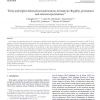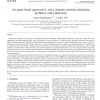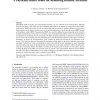3013 search results - page 518 / 603 » HCI for the real world |
AUTOMATICA
2007
2007
Three and higher dimensional autonomous formations: Rigidity, persistence and structural persistence
13 years 9 months ago
In this paper, we generalize the notion of persistence, which has been originally introduced for two-dimensional formations, to Rd for d 3, seeking to provide a theoretical framew...
EAAI
2007
13 years 9 months ago
2007
Multi-agent systems are widely used to address large-scale distributed combinatorial applications in the real world. One such application is meeting scheduling (MS), which is deļ¬...
BC
2005
13 years 9 months ago
2005
Abstract Weproposeacomputationalmodelofcontourintegration for visual saliency. The model uses biologically plausible devices to simulate how the representations of elements aligned...
CGF
2004
13 years 9 months ago
2004
Individually visible scratches, also called isolated scratches, are very common in real world surfaces. Although their microgeometry is not visible, they are individually percepti...
KI
2002
Springer
13 years 9 months ago
2002
Springer
While empirical evaluations are a common research method in some areas of Artificial Intelligence (AI), others still neglect this approach. This article outlines both the opportun...



